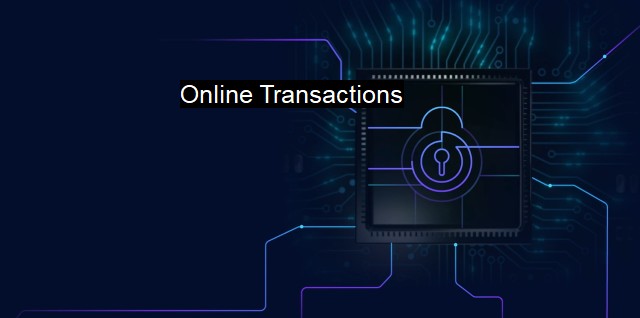What are Online Transactions?
The Rise of Online Transactions: Convenience and Complexity in the Digital Age
Online transactions refer to financial transactions conducted over the internet, which primarily involve monetary exchanges facilitated by digital systems. This type of transaction can include various activities such as online shopping, internet banking, bill payments, investments, and online monetary transfer. The prevalence of these activities has surged due to advancements in technology and the increasing adoption of digital modes of payment for ease, convenience, and quicker processing of transactions.In this digital era, online transactions are being carried out on a colossal scale, making the cyberspace a widespread platform for financial activities. This advancement has made managing finances seamless institutions, consumers, and businesses. the sophistication in technologies has also increased the vulnerability for cyber threats. As such, cybersecurity is paramount in safeguarding these online transactions from various potential threats.
To begin with, cybersecurity is a practice designed to protect systems, networks, and data from cyber threats. These threats may come in the form of Hackers who exploit weaknesses found in digital systems for nefarious purposes, cybercriminals whose intent is to commit fraud, or even malicious software known as malware. In the context of online transactions, it’s critical to ensure that confidentiality, integrity, and availability of sensitive data are maintained to prevent unauthorized access or alteration and to ensure it’s readily accessible when required.
Harmful entities continuously create new ways to bypass security systems. For this reason, every aspect involved in performing online transactions, including ATM machines, payment gateways, databases storing card information, and network systems, must have robust security systems in place to protect data integrity.
As a forefront defense mechanism, antivirus software is commonly utilized. Antivirus software serves to protect systems from cyber threats by detecting, preventing, and taking action against malicious software or activities, which could compromise online transactions' security. In more explicit terms, when you conduct transactions over the internet, antivirus software protects sensitive information by eliminating threats or reducing their potential impact.
Usually, antivirus software records the particular 'signatures' of known viruses. When it encounters files or activities with a matching signature, a scan is triggered to detect any anomalies. If a threat is identified, the antivirus software can remove it, quarantine it for further analysis, or block it to prevent it from causing damage.
An evolving realm like cyberspace witnesses new threats daily, outdating some old virus signatures. For this reason, proactive measures are vital - these may come from heuristic-based detection that spots previously unknown viruses or anomalies that do not match exact signatures but show virus-like behavior, effectively shielding online transactions.
Nonetheless, antivirus software is not infallible due to the speed at which new malware variants are released. emphasis has shifted towards a layered security plan that goes beyond a standard antivirus solution. This ideally includes secure operational practices, malware complaint mechanism, a robust firewall solution, regular data monitoring, timely patch management to plug identified vulnerabilities in the system, and strong data encryption measures rendered during online transactions.
The incorporation of cybersecurity and antivirus measures are critical in creating a secure online transaction environment. They collectively perform as a powerful tool in the battle against cyber threats. creating awareness and educating users about safe practices for online transactions remains an essential complementary factor with these measures.
Online transactions are a ubiquitous aspect of our digital lives, providing unparalleled ease and convenience. The dynamics of cybersecurity and antivirus measures are crucial in safeguarding these transactions, given the escalating cyber threats. As we further immerse into this digital world, understanding and setting up adequate protective measures will only become more essential to assure safe, seamless online transactions.

Online Transactions FAQs
What is an online transaction?
An online transaction is a financial transaction conducted over the internet. This could include anything from purchasing goods or services online, transferring money between bank accounts, or trading stocks on an online brokerage platform.Are online transactions safe?
Online transactions can be safe if certain precautions are taken, such as using a strong password, avoiding public Wi-Fi networks, and ensuring that the website or app being used is secure. However, there is always a risk of cyber attacks and fraud, which is why antivirus and cybersecurity measures are important.How can antivirus software help protect online transactions?
Antivirus software can help protect online transactions by detecting and blocking malware that may be attempting to steal sensitive information. Additionally, many antivirus programs have features for detecting and blocking phishing attempts, which are a common method used by cybercriminals to steal personal and financial information.What steps can I take to secure my online transactions?
There are several steps you can take to secure your online transactions, including: 1. Use a strong, unique password for each online account. 2. Avoid using public Wi-Fi networks when making financial transactions. 3. Only use reputable websites and apps for financial transactions. 4. Make sure the website or app is using a secure connection (https://). 5. Consider using two-factor authentication for added security. 6. Keep your antivirus software and operating system up to date to ensure the best possible protection against cyber threats.| | A | | | B | | | C | | | D | | | E | | | F | | | G | | | H | | | I | | | J | | | K | | | L | | | M | |
| | N | | | O | | | P | | | Q | | | R | | | S | | | T | | | U | | | V | | | W | | | X | | | Y | | | Z | |
| | 1 | | | 2 | | | 3 | | | 4 | | | 7 | | | 8 | | |||||||